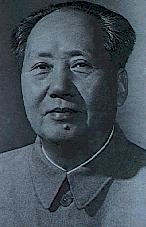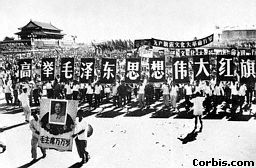Abstract

Maoism, like any other philosophy, incorporates homeland tradition and
culture into the doctrines that bind together the society. Maoism began
as an alteration of Marxist and Leninist principles. Despite the many similarities
that exist between Marxism and Leninism, the Chinese believe Maoism to
be an entirely different branch of socialism. The theories not only differ
in the formation of a socialist state but also between the doctrines of
continuing the socialist society. Mao Tse-tung introduced a new way of
thought in regards to revolution, new military and political doctrine,
a new conception of the Party, and new international and foreign policy.
Historical
Background
The teaching of Marxism influenced a number of Chinese intellectuals.
Karl Marx and Fredrich Engles offered a vision of a perfect and just society
in which socialism prevailed. Li Dachao and Chen Duxiu were students of
this revolutionary and nationalistic Marxist philosophy. During the May
4th Movement, Li Dacho and Chen Duxiu along with the comintern Voytinsky
formed the Communist Party of China. Under pressure from Sun Yatsen and
the Kuomintang, the Chinese Communist joined the Kuomintang.
When the CCP began to strengthen, Chiang Kai-shek attempted to end it
by conducting a string of five campaigns with the intent to wipe out all
the communists. Mao Tse-tung was among the few CCP leaders to escape the
destruction of Chiang Kai-shek. Fearing for this life Mao fled to the south
of China,where he regrouped his army. After Chiang Kia-shek's army attacked
Mao in the Jiangxi Soviet, Mao and his supporters began The Long March
north. They eventually settled in the Shesi province, which served as the
base for the communist party. The province was populated by poor peasants;
Mao's socialist vision captured the hearts of the peasantry greatly. Mao
convinced them to join his masses.
Research
Report

Like many others of the time, Mao was a revolutionist and supporter
of Marxism . He desired a Marxist revolution to overcome the weak state
of China. He wanted China to become more competitive in the global economy
and political arena. The masses of people would be liberated and no longer
exploited by the laborers. It is essential to explore the principle of
Marxism and Leninism in order to develop an understanding of Maoism. These
three philosophies are alike in that they believe that a socialist revolution
must occur, however they differ on the people who ignite the revolution
and when it will occur.
According to Marx, the socialist revolution will occur when socioeconomic
conditions in a society have emerged and are consistent with the possibilities
of a socialist order. In order for this to happen a dominating capitalistic
society must be in decline leaving an ambitious industrial working class
refusing to be satisfied with the present state. The proletariat class
will then rebel against the capitalism and eventually overthrow the bourgeoisie
resulting in the establishment of purely egalitarian state. Revolution
will continue under the dictatorship of the proletariat to prevent the
restoration of capitalism and continue the advance towards communism. During
Marx's own time, the stage for this revolution was in the capitalistic
societies of England, Germany, and possible the United States. Despite
the lack of development, Russia was the sight of the first successful
Marxist revolution. The state of Russia in 1917 was hardly that of an appropriate
sight for a Marxist revolution to occur. After ignoring prerequisite socioeconomic
conditions, Lenin seized power and forced the application of the Marxist
theory to the Russian state.
Mao, like Lenin, tailored Marxism to fit his own nations state of affairs.
The Marxist principle says that revolution will occur under the right,
organically evolved, socioeconomic conditions. It is then that the proletariat
will act and take advantage of these conditions. The theory ensures that
a revolution will occur but not necessarily on the time schedule of the
revolutionists. Lenin and Mao did not wait for these preconditions to occur
but launched a revolution under circumstances that fit their own
ambitions.
The situation in China lacked a foreseeable application of the Marxist
and Leninist model. China was still operating as a semi-feudal country,
economically further behind than Russia. Since China lacked the presetting
for a Marxist revolution to create a socialist state, it was essential
to form a new philosophy and practice it. Maoism is the reaction to China’s
inability to conform to the situation present in Marxism and Leninism.
Maoism interprets Marxism and Leninism to a completely new stage
of thought. Political Philosopher, Wolfgang Leonhard, states that:
Maoism is the elevation of Marxism-Leninism to a new, third,
and superior stage in the development of the construction of socialism.
Marxism-Leninism-Maoism combines to form a whole; it is an ideology of
the proletariat synthesized to cultivate new stages. Maoism had its beginnings
in the endeavor to transfer the political tenants of Marxism and Leninism
to China’s dramatically different conditions. The most influential adapter
of Marxism to Asia was the changing focus from the urban proletarian to
the peasantry. The Communist used military power and peasant organization.
Stress on patriotism and national survival.
The state of China was a very midieval society, thus creating an obstacle
to Mao's cultural revolution. Confucianism still greatly influenced the
Chinese people. People were reluctant to disturb the social harmony;
it was taboo to challenge the authority. According to Maoism, the first
obstacle to overcome in the social revolution was to form an anti-feudal
revolution and overcome the ancient way of life. Since the proletariat
class only constituted 1% of the Chinese population, it was necessary for
Mao to motivate the peasantry to culminate the force behind the revolution.
Mao persuaded the peasants to rebel against their landlords by impressing
upon them tthe reward that the revolution will bring them. Mao's theory
was attractive to many.
The Chinese revolution was a part of the world proletarian revolution
directed against imperialism; internally the country should be ruled by
joint dictatorship of several parties. The primary goal of the Chinese
Revolution was to carry out a national revolution to overthrow foreign
imperialist oppression and instill in the Chinese people a sense of self-reliance.
Once this was completed the focus turned to carrying out a democratic revolution
to overthrow feudal landlord oppression.
The New Democratic Revolution
and The Three-Thirds Government
One of the objectives of the Chinese revolution was to create a “new
democracy” that would differ from the western industrial and soviet democratic
models. The revolution resulted in the establishment of a socialist state.
Politically, the “new democracy”, was marked neither by a bourgeois dictatorship
nor by a dictatorship of the proletariat but by a joint dictatorship of
all the revolutionary classes. In Mao’s “Sinification of Marxism”, he called
for a Chinese political theory of communism that not only adapted to Chinese
conditions but also to the mentality and cultural tradition of the Chinese
people. In 1940, Mao Tse-tung developed the new democratic revolution
by implementing the three-thirds system. Under this system, 1/3 of the
seats went to the communist, 1/3 to the petty merchants that constitute
the Left wing progressives, while the Right wing middle bourgeoisie occupied
the remaining seats. The three-third system was imperative to winning over
all the people to the communist ideology forming the People’s Democratic
dictatorship. The People’s Democratic dictatorship would rule China in
the name of peasants, workers, and the petty and national bourgeoisie.
The result of this united party would be the collapse or transformation
of the enemy landlord class.
In the “new democracy”, the state sector was to constitute the leading
force behind the national economy. Great banks and major industrial and
commercial enterprises were nationalized. However, the government would
not confiscate private property or interfere with the development of capitalist
production. Agriculturally, landlords would no longer own the land. The
land would now be divided up and redistributed among the peasants.
During this Cultural Revolution, Mao did not want the Chinese to distance
themselves from Chinese experience and tradition. He urged the communist
party members to detach themselves further from the soviet model. Mao began
to create a number of books discussing his philosophy of combining Marxism
with Chinese tradition. In these works, he criticized the soviet model
and warned the Chinese to be weary of foreign influence. Mao stated in
one of his popular books of thought, that "China has suffered a great deal
from the mechanical absorption of foreign material".
Maoism differs from the soviet model of socialism. While the Soviet
model emphasizes on economic planning, “moral-political unity’, and the
“leading role of the party” in the intellectual and cultural realm, non
of these characteristics are present in Maoism. Rather, Maoism is focused
on the opposition and discrepancies in the socialist civilization. Mao
saw a number of contradictions present in the Chinese society. “Contradictions
between the working class and the peasantry, contradictions between the
intellectuals and the working class” all occurred. In 1956-1957, Mao launched
the “Hundred Flowers” campaign. During this time he hoped to reveal the
method for revealing and resolving conflicts. People were free to openly
express criticism, however Mao’s mistakes could not be criticized.
Maoism has a disdain for the intellectuals of China; Mao blamed
them for the weaknesses of China. The intellectuals are a threat because
they have the potential to form an elite class that would enjoy the priveleges
that are unattainable for the workers and the peasants. The intellectuals
are a danger in the political world as well, they threaten the authority
of the CCP.
Since the intellectuals are seen as the enemy, Maoism gives allows them
to be harassed, repressed, and humiliated. These acts can be carried out
in order to eliminate the threat. Maoism focuses on educating the youth
in accorance with the thoughts and principles of Mao. The youth constituted
the future of Maoism, they were loyal to Mao.
Historical
Significance
Mao transformed the image of China. China was once a weak country divided
up among numerous foreign powers. After Mao's cultural revolution, China
now stood strong in the world.The foreign attitude towards China was now
that of respect and fear.The Chinese nationals now felt a sense of self-reliance
and strength.
Despite the death of Mao Tse-tung, Maoism continues to exist. Maoism
is more strongly evident in modern day China than the soviet model of Marxism
and Leninism. Developing nations in Asia, Africa, and Latin America have
begun to adapt the Mao’s perspective on revolution and socialism. Chairman
Gonzalo ofthe Communist Party of Peru stated that "Maoism, embodying itself
within the peoples of the world, is marching unstoppably to command the
new great wave of the world proletarian revolution".
References
An, Tai Sung. Mao Tse-Tung’s Cultural Revolution. USA: Pegasus,
1972.
Hsiung, James Chieh. The Logic of Maoism, Critiques and Explication.
USA: Praeger Publishers Inc., 1974
Lazerini, Edward J. The Chinese Revolution. Westport Conn.:
Greenwood Press, 1999.
Leonhard, Wolfgang. Three Faces of Marxism. New York: G.P. Putnam’s
Sons, 1974.
Meisner, Maurice. Marxism, Maoism, and Utopianism. Madison:
The University of Wisconsin Press, 1982.
Web Resources
www.maoism.org
http://crsp.org/rim/longlinemlm.htm
(Longlive Marxism-Leninism-Maoism)
http://www.marxist.com/china.asp
(China and Marxism)
http://www.maoism.org/msw/mao_sw.htm
(Selected works by Mao Tse-Tung)
http://www.planio.it/linearossa/lrengmao.htm
(The Party Red Line- Mao Zedong Biography)

